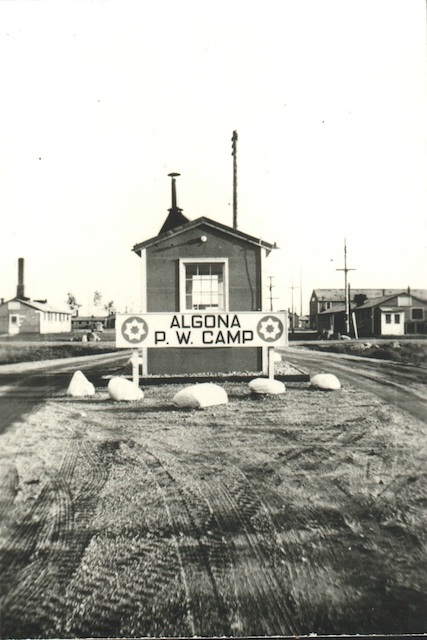
World War II German prisoners of war began arriving at Camp Algona in 1944. Photo courtesy of Camp Algona POW Museum
Sept/Oct 2023 (Volume 15, Issue 5)
(Publisher’s note: Our two-part series about Iowa’s World War II POW camps will continue in our November/December issue and focus on Japanese prisoners at Clarinda’s POW camp.)
By Don Doxsie
Viewed from a distance, through newsreels and newspapers, World War II must have appeared unbelievably frightening for residents of Iowa in the early 1940s.
They would have seen images of rampant death and destruction, most of it inflicted by scary-looking troops from Germany, Italy and Japan.
So, when they learned that some of the perpetrators of that carnage were going to become their new neighbors, you might have thought they would feel nothing but trepidation and apprehension.
That wasn’t entirely the case. When Iowans discovered there would be two major prisoner of war camps in their state housing captured enemy soldiers, they seemingly were more curious than they were scared. And most of them eventually came to regard the presence of the camps as a blessing.
Most modern-day Iowa residents don’t realize that thousands of prisoners of war once inhabited their state. By the time World War II ended in 1945, there were more than 500 POW camps in 45 of the 48 states in the U.S., except North Dakota (which did have branch camps), Vermont and Nevada. They housed about 425,000 prisoners from the other side of the globe with at least 25,000 POWs residing in Iowa.

German POWs are pictured helping load timber onto the back of a truck as part of a work detail. Photo courtesy of Camp Algona POW Museum
The two primary camps in the state were in Algona, in Kossuth County about two hours north of Des Moines, and in Clarinda, about two hours southwest of Des Moines in Page County. Great care was taken to place the camps far away from large population centers or military installations.
There were almost three dozen smaller branch camps scattered around the state, in places such as Muscatine, Clinton, Eldora, Waverly, Shenandoah, Charles City, Tabor, Onawa, Storm Lake and Toledo. Some were located in abandoned Civilian Conservation Corps buildings and county fairgrounds. There were camps at Wartburg College, the vacated Tabor College campus, the Fairport Fish Hatchery near Muscatine, the Sac and Fox Sanitarium in Toledo, the Wildwood Park clubhouse in Charles City and an old country estate in Storm Lake.
In the early stages of the war, German and Italian soldiers who were captured were sent to camps in Great Britain, but it didn’t take long for the Brits to run out of space. Cargo vessels were shuttling back and forth across the Atlantic Ocean anyway and those ships began transporting prisoners, first to the southern part of the U.S. and eventually to almost every corner of the country.
The two primary camps in Iowa were constructed specifically for the war and were mirror images of one another. Both had a double row of 10-foot-high chain link fences topped with barbed wire and they included eight guard towers equipped with .30 caliber machine guns, 400-watt searchlights and sirens.
Each of them included 186 buildings, comprised mostly of no-frills wooden barracks constructed on concrete slabs and designed to hold 50 prisoners. There were accommodations for 3,000 POWs and 500 military people at each camp. They were divided into four compounds with one of those devoted to the U.S. soldiers and the other three each containing 20 barracks for prisoners. The camps also had mess halls, a barn, a machine shop, an icehouse, a fire station, a chapel, movie theaters, a stockade for the incarceration of prisoners who caused trouble and a 150-bed hospital.
The Clarinda camp was built at a cost of $1.3 million about a mile-and-a-half south of town on a 273-acre piece of farmland formerly owned by Oscar Youngmark. The identical Algona camp, which cost $1.28 million, was about two miles west of town on a 287-acre plot that was purchased from four different farmers at a cost of $120 per acre. Construction on both camps began in the summer of 1943 and both began accepting prisoners very early in 1944.
Over the course of two years, Camp Algona housed 10,000 German and Italian prisoners although there seldom were more than 2,500 there at any one time. Camp Clarinda generally had fewer inhabitants, but late in the war it became one of the few camps to house Japanese captives.
TO READ THE ENTIRE STORY AND OTHER FASCINATING STORIES ABOUT IOWA HISTORY, subscribe to Iowa History Journal.
